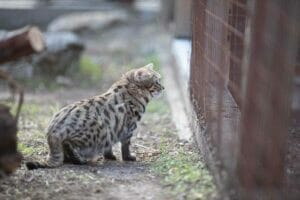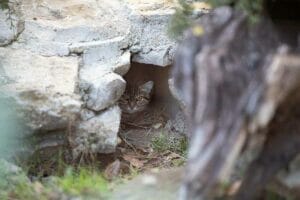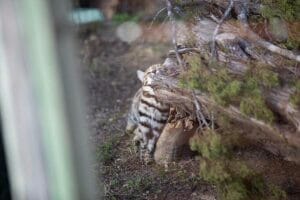
Appearance
The black-footed cat, or small-spotted cat, is one of the smallest cat species in the world, as well as the smallest cat in Africa. They typically weigh in at 2-5 pounds and measure only 14-20 inches in length, whereas typical house cats weigh 10 pounds on average. Despite their small size, they are quite tenacious and have been known to defend themselves against jackals that are eight times their size. Their rounded, low set ears give them exceptional hearing, and are usually flattened in an aggressive posture for camouflage while hunting in areas with limited cover. In addition to the strong sense of hearing, they also have excellent night vision.
Adaptations
Black-footed cats are well-adapted to survive in the scrub deserts of southern Africa. Due to the blazing temperatures of their natural habitat, these felids have developed black paw pads covered with thick fur, which insulates their feet from hot sand.
Black-footed cats need to spend a lot of time hunting in order to fuel their extremely fast metabolism. Consequently, these cats are quick, agile hunters, able to travel up to 10 miles every night and successfully complete a hunt every 30-50 minutes. Their skills are so honed that they have the highest successful kill rate of any felid.
Conservation
In 2019, it was estimated that only about 10,000 black-footed cats remained in the wild. Their secretive nature makes conservation difficult, however, international organizations have been making progress through several field studies. In addition to captive studies, radio collars have helped detect the process of their nocturnal hunts with the help of an advanced, light-sensitive camera.
Not only are deforestation and habitat loss a major threat to this species, but overgrazing by livestock and even indirect poisoning. Fossil Rim currently works with the Black-Footed Cat Consortium to breed the species. In 2019, a female gave birth to the first two black-footed cat kittens in Fossil Rim history. Successful litters have been born in subsequent years.
Where are they?
Two black-footed cats can be visited at Animal Discoveries. Because of their shy nature, the others live in the Intensive Management Area and can only be visited on a Behind-The-Scenes Tour.
VIEWING TIPS
Though these cats can sometimes be seen sunning or hiding in plain site, they will likely require keen observation, as they are quite stealthy as a species.
Quick Facts
Scientific Name | Felis nigripes |
Species Survival Plan | No |
Habitat | Scrub desert and sandy or grassy plains |
Food | Wild - rodents, birds, spiders, insect and small reptiles |
Originally Native To | South Africa, Botswana and Namibia |
Weight | 2 - 5 lb. |
Characteristics | Cinnamon to tawny coat with dark brown to black spots that merge to form dark bands or rings on the chest, legs and tail; short, black-tipped tail with 2-3 black rings near the tip; low-set, flattened ears and large eyes; black pads and dark fur on the underside of feet |
Lifespan | Wild 13 years |
Social Behavior | Solitary except for a short period of time for breeding and when a mother is rearing young |





